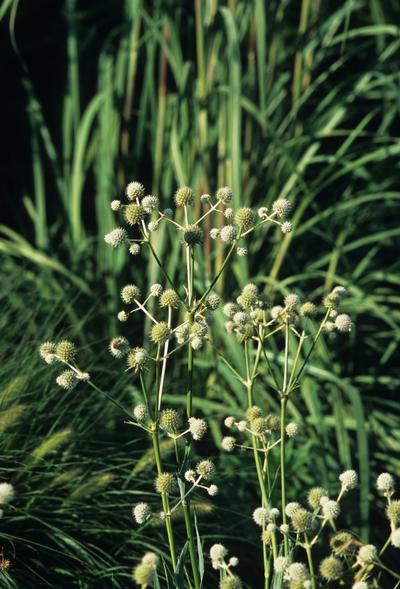Printed at http://www.newmoonnursery.com/index.cfm/
Eryngium yuccifolium
Rattlesnake master
Native to North America
FIRST IMPRESSIONS: And now for something completely different! Eryngium yuccifolium starts the growing season as a rosette of attractive bluish sword shaped leaves. As summer approaches, branched stems soar upward bearing curious spherical flower clusters. The rounded flower orbs are actually compressed umbels with tiny creamy white florets. Spiny globular seed masses follow and are held into the winter. This is a striking architectural accent plant or stalwart prairie companion that is easy to grow in sun and well drained or dry soil.
HABITAT & HARDINESS: Eryngium yuccifolium occurs in the eastern United States from Maryland to Minnesota and south to Texas. Plants are absent from West Virginia and some of the New England states.
This species is indigenous to tallgrass prairies, Blackland prairies, clay and sand prairies, pinelands, sandy open woods, savannas and limestone glades.
Plants are hardy in USDA Zones 3-9.
PLANT DESCRIPTION: Eryngium yuccifolium is a unique member of the Carrot or Parsley Family. This robust perennial resembles a desert plant and is often compared to a yucca.
Plants originate from a sturdy taproot. The unique leaves are arranged in a basal rosette. Offsets develop from the rosette and eventually a 2-3’ tall clump of several plants forms.
Plants have stiff strap shaped leaves with scattered bristles along the margin. Leaves are thick and leathery with a bluish-green or gray-green color.
In summer a long stalked inflorescence emerges containing several 1” prickly flower globes. Each sphere contains many small white florets with a rosette of small spiny leaves at the base. The blooms are often fragrant and are usually teeming with pollinators.
Blooming occurs for about a month before the flower balls transition into globular seed clusters. Overall the flower and seed display is attractive for at least 2 months.
Plants are 2-5’ tall with 1-2’ spread.
CULTURAL & MAINTENANCE NEEDS: Eryngium yuccifolium grows best in sunny sites with average well drained soil. Plants also adapt to sandy, clay, gravelly, alkaline or shallow rocky soils.
This species is very drought tolerant but will not tolerate poor drainage.
Plants are pest resistant and are unpalatable to deer and other herbivores.
LANDSCAPE USES: This unique species is a wonderful Accent Plant for a Wildlife Garden. In a Prairie or Meadow, scatter small Groups of plants in drifts among the grasses. Eryngium yuccifolium is also used as Butterfly Nectar Plant or Cut Flower. Plants provide Fragrance, Showy Blooms and Winter Interest. They are valuable components of Cottage Gardens, Deer Resistant Plantings, Rock Gardens, Water-wise Landscapes, Low Maintenance Plantings, Perennial Borders and Prairie Restoration Projects.
COMPANION & UNDERSTUDY PLANTS: Eryngium yuccifolium mingles well with flowering prairie residents like Allium cernuum, Asclepias tuberosa, Echinacea purpurea and Liatris aspera. This species also combines beautifully with prairie grasses like Andropogon gerardii. Panicum virgatum, Sorghastrum nutans and Sporobolus heterolepis.
There is no look-alike for this quirky individual. Echinacea purpurea or the cultivars ‘White Swan’ and ‘Powwow White’ do grow in similar circumstances and might be substituted in a pinch.
TRIVIA: Beneficial pollinators including native bees, wasps, butterflies, skippers, moths and beetles seek nectar and pollen from the flowers.
The common names, ‘Rattlesnake Master’ and ‘Button Snake-root’ are used because Herbalists and Native Americans believed the root was an antidote for snakebite.
Height:
2-5 ftSpread:
2 ftSpacing:
2-3 ftUSDA Hardiness Zone:
3-9Bloom Color:
Green, WhiteEryngium yuccifolium Characteristics
Attracts Wildlife
- Songbirds
- Pollinators
- Butterflies
Attributes
- Dried Flower
- Cut Flower
- Rock Garden
- Clay Soil
- Naturalizing
- Long Blooming
- Interesting Foliage
- Drought Tolerant
Exposure
- Full Sun
Flowering Months
- July
- June
- September
- August
Foliage Color
- Green
- Gray-Green
Growth Rate
- Medium
Juglans nigra Tolerance (Black Walnut)
- Yes
Phytoremediation
- Pb-Lead
- Cu-Copper
Season of Interest (Foliage)
- Fall
- Summer
Soil Moisture Preference
- Dry to Moist

